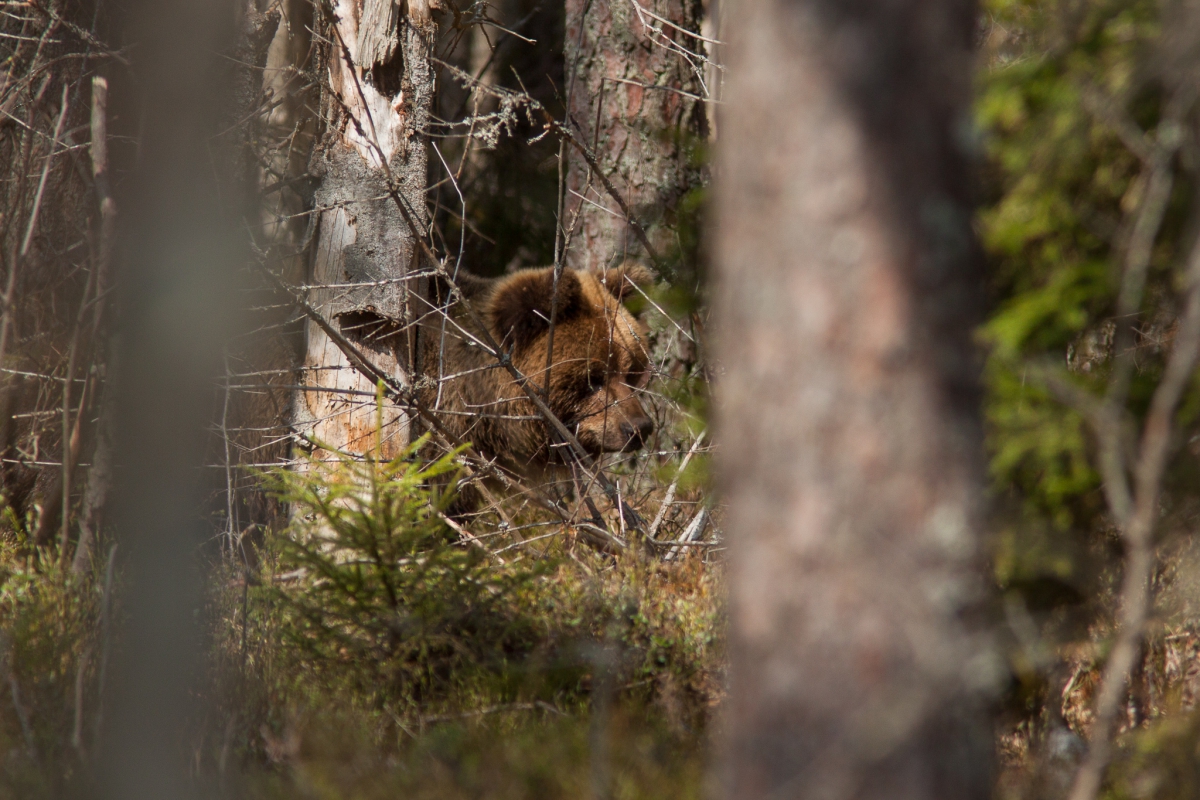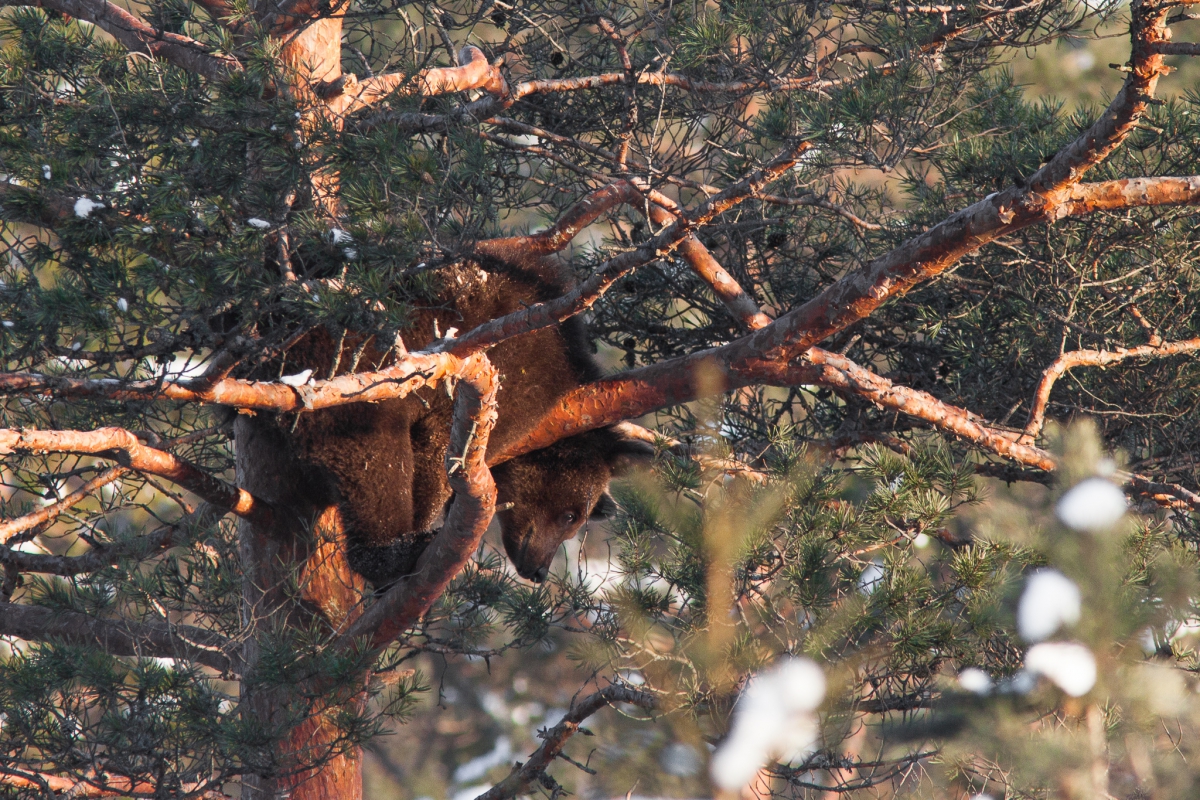
Posted by the Animal of the Year team, 12.11.2016
As about wolves, we see time and again in the news that a bear has attacked a human. In fact in case of an attack from one of our brown bears - which happens extremely rarely – it has been a warning attack after which the animal itself quickly has fled.
Photo: Tarmo Mikussaar
Two weeks ago information arrived from Romania that in the Transsylvanian region near Brasov a brown bear attacked a 20-year old American tourist. Two brothers had gone hiking when suddenly a male brown bear appeared out of the forest. It approached them rising on its hind legs and roaring. One of the brothers made a loud noise hoping to scare the bear but since the animal did not go away the brothers started running away from it. After that the bear started chasing them and attacked one of them biting his arm. Then however the bear left and the brothers called for paramedics. According to a representative of the medical team, Ciprian Sfreja, the man had been attacked by a 100 kilo bear that caused a 2-3 centimetres long wound on his left arm. The man was brought to a hospital and the local authorities reported that his health is improving.
About 5000–6000 bears live in the Transylvanian region.
See also http://www.nytimes.com/aponline/2016/10/29/world/europe/ap-eu-romania-bear-attack.html?_r=0
Forester Vahur Sepp comments:
In the Romanian incident the attacker was allegedly a male bear weighing 100 kilograms. In Estonian conditions this would mean that it was a young bear. However, bears in Romania are smaller. The more northwards a species lives the bulkier it is. Thus I cannot give an exact age for the animal. It will remain a riddle how the sex was determined. In case of a single individual it can only be judged with certainty after the animal has been hunted down. An experienced observer with binoculars may – given sufficient time – draw conclusions without disturbing the animal. A bear rises to its hind legs mostly to study the situation. If a roar and a fast escape follow then it is frightened. The observed object (the human) was simply terrifying. In a moment the animal’s bowels go loose and it fouls all over its escape tracks. Sometimes rising to the hind legs is also done to scare an adversary – se how big I am! It is accompanied by roaring and growling. Such fright tactics are generally used against cospecifics.
Evidently the bear with its poor eyesight thought the brothers this time were rivals who had invaded his territory. In such a case it is not worthwhile to roar, but rather to retreat while calmly talking to the animal. The most stupid thing is to give in to fright and flee at a run. A man cannot in most cases run faster than the animals in the forest anyway. The rule is that only food runs in the forest. A fast escape may release the attacking instinct in a bewildered bear.
So it happened this time too. Only when the predator grabbed the arm of one of the boys it realised that it had to do with a human. The attack stopped instantly. Such a small wound as 2-3 centimetres is quite difficult for a bear to cause. It can be surmised that after that the frightened animal saved itself by a fast escape.

Photo: Tarmo Mikussaar
Since we already are on the subject of attacks here, an attack may be mentioned that occurred in Estonia and that has been discussed by Valdur Mikita in his book "Lingvistika ehk metsa see lingvistika", in the chapter "Välgi metsa hirm - The terror of Välgi forest", pp 93-96:
"... Even today there may be people in Estonia who have been in the jaws of a bear. The latest such incident dates from some years back. In 2011 in Jõgevamaa in the parish of Puurman a bear attacked a man who had gone out in the forest in the evening. The man had been looking in a cleared area for borer beetles for going fishing and came across a female bear and two cubs in the forest. The angry bear struck the man down and started to tear at him with her fangs. The former gamekeeper however was not faint-hearted and started hitting the bear with a stick that he happened to reach so that blood splashed from the bear’s nose ..."
Vahur Sepp comments:
The bear attack that occurred in the Puurman parish in spring in 2011 and is described by Valdur Mikita has a logical explanation.
Bears have cubs every two years. The offspring that is born around Twelfth Day is helpless and extremely small. They weigh less than 300 grams. The female bear licks them clean and settles them at her teats instinctively, acting without really thinking about the moves. If such a bear is woken up from the nest it flees and will not return to the cubs. The newly born will inevitably perish.
Bears in Estonian forests wake up from their winter sleep, regardless of the weather, around Women’s Day. It seems that the right time is decided by day length. Firstly single bears get out, straying around, Those who have born cubs in January wake up too. From the rich milk the little ones have grown to the size of a fur cap, but they are still too weak to leave the nest. The nest that was arranged for hibernation is left when Hepaticas are in full flower. Depending on the spring it happens sometime in mid-April. The maternal instinct to protect her young grows in the female bear in the first half of March. She will no longer abandon her offspring and is prepared to fight whoever comes for them. If you approach such a nest the bears lie motionless and hope that the danger will pass.
Precisely this happened to the Puurman parish man. He stepped straight into the bear’s nest. The female bear with her cubs held her breath until the last moment – maybe he does not notice, perhaps he walks past! When it became clear that hiding did not help, the attack came. The female bear gripped the man by his knees with her jaws and threw him away from the nest. After that she fled together with the cubs. The aim of the attack was not to kill but to deter and win time for escape from the dangerous adversary.
Beating the bear with a stick is just a fictional embellishment. Of course at the same time we feel proud that men who have fought a bear without firearms still live in Estonia.


